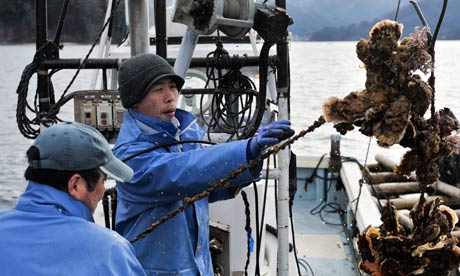 Oyster farmers Masashi Shirano, left, and his son Takashi harvest oysters on their boat off Yamada, one of the towns devastated by the tsunami. Photograph: Kimimasa Mayama/EPA
Oyster farmers Masashi Shirano, left, and his son Takashi harvest oysters on their boat off Yamada, one of the towns devastated by the tsunami. Photograph: Kimimasa Mayama/EPA No one can begrudge Hiromi Ito the look of pride on his face as he lifts a rope laden with baby scallops from the sea off Ogatsu. A year ago, he watched in horror as – in a few terrifying minutes – the tsunami destroyed his village's aquaculture industry, the lifeblood of the local economy.
Today, the seascape is improbably idyllic: mountains silhouetted against a pale winter sky, and calm waters where rows of buoys mark the starting point for Ogatsu's renaissance.
Back on shore, however, little has changed. The tsunami killed 235 people in Ogatsu and swept away almost all of its buildings. The force of the earthquake nudged the coastline eastward and caused it to sink by about a metre.
No construction work will take place here for at least two years, says Ito, while residents decide where, and if, to rebuild. He believes that its best chance of recovery lies in the nutrient-rich waters that made Ogatsu famous for oysters, scallops, sea squirt and salmon: "I looked at the devastation and decided there and then that we had to build a new kind of business run by fishermen, for fishermen."
He and 10 other fishermen attracted the interest of restaurant owners and marketers, and Oh Guts – an English play on the village's name – was born.
Rather than wait for official compensation, the venture sought private investments of 10,000 yen (£78) a share, a scheme Ito says is a first for the Japanese fishing industry. By the end of last year it had sold 20,000 shares, and hopes to reach the 50,000 mark within five years. The money will be used to replace lost boats and equipment; investors, who will be invited to take a hands-on role in cultivation, will be repaid in fresh seafood.
Ogatsu's fledgling recovery is being repeated in other parts of Miyagi prefecture, where 9,500 people died and 1,700 are missing.
In Higashi Matsushima, 100 fishermen are bringing in hauls of the town's enormous oysters. The famed islands that dot the bay deprived the tsunami of some of its ferocity, but not enough to save the oyster beds.
"We had just finished harvesting that year's oysters, but the tsunami swept away all the seeds for the following year," says Masami Hachiya, president of the local fisheries co-operative. "We had to start from scratch."
Using seed oysters brought in from outside, the first batches of oysters – even bigger than usual because there are fewer of them sharing the bay – are already on sale.
"Production and sales are about half of what they were before the tsunami, but it's just enough for us to make a living," Hachiya says, adding that the lucrative clam and whitebait trade would be restarted soon.
Progress in Ogatsu is much slower. The post-disaster exodus inland has cut its population from 4,300 to less than 1,000. The number of fishermen, whose average age was over 60 before the disaster, has fallen from 250 to about 40. It will be two years before any oysters reach maturity, and another year before the sea squirts are ready. That said, the company hopes to produce 1.3m kilos of seafood and turn a modest profit by summer 2013.
Ogatsu's struggle is being repeated across Japan's north-east, where the tsunami caused 1.2tn yen of damage to the fishing industry. In all, 319 fishing ports and 22,000 fishing boats were damaged and last year's total catch was 60% down on the previous year.
The number of fishermen in the region has fallen by a 10th in five years, while only a quarter of those left are below 50. In Miyagi prefecture alone, a third have said they will quit because of the disaster. "We had to stand up and do it for ourselves," says Ito. "We couldn't wait for the bureaucrats behind their desks to help us. The government has passed three supplementary budgets, but it could be another two years before we receive any compensation.
"The difference between us and the government is that I was directly affected by the disaster. I feel like I've died once already … I'm not scared of failure any more. I survived, and I want to make the most of the chance I've been given."
Takashi Tachibana, a food business entrepreneur and a co-founder of Oh Guts, moved from Tokyo to Ogatsu last year to to help market the brand and attract investment.
The idea, he says, is for the fishermen to produce, sell and process everything themselves, bypassing the costly and inefficient distribution system many blame for stifling small Japanese fisheries.
"You can feel the energy of the people here," says Tachibana. "Some fishermen may not like the idea of being employed by outsiders, but they will have direct contact with the people who buy their products. That makes a huge difference."
For Ito, restructuring is a small price to pay for the chance to board his boat and inspect beds teeming with oysters and scallops. "We don't bear a grudge against the sea," he says. "It took away our living and our loved ones, but now it's beginning to give something back."

No comments:
Post a Comment